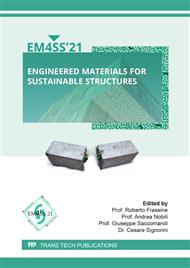[1]
S. Apithanyasai, N. Supakata, S. Papong. The potential of industrial waste: using foundry sand with fly ash and electric arc furnace slag for geopolymer brick production. Heliyon, 6 (2020). https://doi.org/10.1016/j.heliyon.2020.e03697.
DOI: 10.1016/j.heliyon.2020.e03697
Google Scholar
[2]
F. Colangelo, A. Petrillo, R. Cioffi, C. Borrelli, A. Forcina. Life cycle assessment of recycled concretes: A case study in southern Italy. Science of The Total Environment 615 (2018) 1506-1517. https://doi.org/10.1016/j.scitotenv.2017.09.107.
DOI: 10.1016/j.scitotenv.2017.09.107
Google Scholar
[3]
J. L. Provis, 2018. Alkali-activated materials, Cement and Concrete Research 114 40–48. https://doi.org/10.1016/j.cemconres.2017.02.009.
DOI: 10.1016/j.cemconres.2017.02.009
Google Scholar
[4]
M. Ohno, V.C. Li, 2018. An integrated design method of Engineered Geopolymer Composite. Cement Concr. Compos. 88, 73e85. https://doi.org/10.1016/j. cemconcomp.2018.02.001.
Google Scholar
[5]
M. Lahoti, K.H. Tan, E. Yang, 2019. A critical review of geopolymer properties for structural fire-resistance applications, Construction and Building Materials 221 514–526. https://doi.org/10.1016/j.conbuildmat.2019.06.076.
DOI: 10.1016/j.conbuildmat.2019.06.076
Google Scholar
[6]
M.Z.N. Khan, F.A. Shaikh, Y. Hao, H. Hao, 2016. Synthesis of high strength ambient cured geopolymer composite by using low calcium fly ash, Constr. Build. Mater., 125, 809-820.
DOI: 10.1016/j.conbuildmat.2016.08.097
Google Scholar
[7]
R. Abbas, M.A. Khereby, Y. Hanaa, G. Elkhoshkhany, 2020. Preparation of geopolymer concrete using Egyptian kaolin clay and the study of its environmental effects and economic cost, Clean Technologies and Environmental Policy, 22, 669–687, https://link.springer.com/article/10.1007/s10098-020-01811-4.
DOI: 10.1007/s10098-020-01811-4
Google Scholar
[8]
A. Hajimohammadi, J.S. van Deventer, 2017. Characterisation of one-part geopolymer binders made from fly ash Waste Biomass Valorization, 8 (1), 225-233.
DOI: 10.1007/s12649-016-9582-5
Google Scholar
[9]
K. Neupane, D. Chalmers, P. Kidd, 2018. High-Strength Geopolymer Concrete- Properties, Advantages and Challenges. Advances in Materials. 7 (2), 2018, 15-25.
DOI: 10.11648/j.am.20180702.11
Google Scholar
[10]
M. Abdulkareem, J. Havukainen, M. Horttanainen, 2019. How environmentally sustainable are fibre reinforced alkali-activated concretes? Journal of Cleaner Production 236 (2019) 117601. https://doi.org/10.1016/j.jclepro.2019.07.076.
DOI: 10.1016/j.jclepro.2019.07.076
Google Scholar
[11]
M.H. Al-Majidi, A.P. Lampropoulos, A.B. Cundy, O.T. Tsioulou, S. Al-Rekabi, 2018. A novel corrosion resistant repair technique for existing reinforced concrete (RC) elements using polyvinyl alcohol fibre reinforced geopolymer concrete (PVAFRGC), Constr. Build. Mater. 164 603–619. https://doi.org/10.1016/j.conbuildmat.2017.12.213.
DOI: 10.1016/j.conbuildmat.2017.12.213
Google Scholar
[12]
M.M. Al-mashhadani, O. Canpolat, Y. Aygörmez, M. Uysal, S. Erdem, 2018. Mechanical and microstructural characterization of fiber reinforced fly ash based geopolymer composites, Constr. Build. Mater. 167 505–513. https://doi.org/10.1016/j.conbuildmat.2018.02.061.
DOI: 10.1016/j.conbuildmat.2018.02.061
Google Scholar
[13]
A. Çomak, A. Bideci, Ö.S. Bideci, 2018. Effects of hemp fibers on characteristics of cement based mortar, Constr. Build. Mater. 169 794–799. 10.1016/j.conbuildmat.2018.03.029.
DOI: 10.1016/j.conbuildmat.2018.03.029
Google Scholar
[14]
X. Guo, X. Pan, 2018. Mechanical properties and mechanisms of fiber reinforced fly ash–steel slag based geopolymer mortar, Constr. Build. Mater. 179 633– 641. https://doi.org/10.1016/j.conbuildmat.2018.05.198.
DOI: 10.1016/j.conbuildmat.2018.05.198
Google Scholar
[15]
G. Mucsi, Á. Szenczi, S. Nagy, 2018. Fiber reinforced geopolymer from synergetic utilization of fly ash and waste tire, J. Cleaner Prod. 178 429–440. 10.1016/J.JCLEPRO.2018.01.018.
DOI: 10.1016/j.jclepro.2018.01.018
Google Scholar
[16]
P. Duxson, J.L. Provis, G.C. Lukey, J.S.J. van Deventer, 2007. The role of inorganic polymer technology in the development of "green concrete, Cement Concr. Res., 37, 1590-1597.
DOI: 10.1016/j.cemconres.2007.08.018
Google Scholar
[17]
D.A. Salas, A.D. Ramirez, N. Ulloa, H. Baykara, A.J. Boero, 2018. Life cycle assessment of geopolymer concrete, Construction and Building Materials, 190, 170-177.
DOI: 10.1016/j.conbuildmat.2018.09.123
Google Scholar
[18]
T. Stengel, J. Reger, D. Heinz, 2009. Life cycle assessment of geopolymer concrete – what is the environmental benefit? Concrete 09, 24th Biennial Conf Australian Concrete Institute. Concrete Institute of Australia, 54-62 Sydney, Australia.
Google Scholar
[19]
ISO, 2006. ISO 14040:2006 Environmental management - Life cycle assessment - Principles and framework.
DOI: 10.1065/lca2005.03.001
Google Scholar
[20]
ISO, 2006. ISO 14044:2006 Environmental management - Life cycle assessment - Requirements and Guidelines.
DOI: 10.3403/30290345
Google Scholar
[21]
P. Van den Heede, N. De Belie, 2012. Environmental impact and life cycle assessment (LCA) of traditional and green, concretes: Literature review and theoretical calculations. Cement and Concrete Composites, 34 (4), 431–442.
DOI: 10.1016/j.cemconcomp.2012.01.004
Google Scholar
[22]
M.A.J. Huijbregts et al., 2016. National Institute for Public Health and the Environment. ReCiPe 2016, A harmonized life cycle impact assessment method at midpoint and endpoint level Report I: Characterization RIVM. Report 2016-0104.
Google Scholar
[23]
Schneider P., Oswald K.-D., Riedel W., Meyer A., Schiller G., Bimesmeier T., Pham Thi V.A., Nguyen Khac L., 2018. Engineering Perspectives and Environmental Life Cycle Optimization to Enhance Aggregate Mining in Vietnam. Sustainability, 10, 525. https://doi.org/10.3390/su10020525.
DOI: 10.3390/su10020525
Google Scholar
[24]
Fawer M., Concannon M., Rieber W., 1999. Life cycle inventories for the production of sodium silicates. The International Journal of Life Cycle Assessment, 4, 207.
DOI: 10.1007/bf02979498
Google Scholar
[25]
Dorn C., Behrend R., Giannopoulos D., Napolano L., García Baños B., James V., Uhlig V., Catalá J.M., Founti M., Trimis D., 2015. KPI and LCA Evaluation of Integrated Microwave Technology for High Temperature Processes. Procedia CIRP, 29, 492-497. https://doi.org/10.1016/j.procir.2015.02.033.
DOI: 10.1016/j.procir.2015.02.033
Google Scholar
[26]
Spath P. L., Mann M. K., Kerr D. R., 1999. Life Cycle Assessment of Coal-fired Power Production. United States. Web. 10.2172/12100.
DOI: 10.2172/12100
Google Scholar


